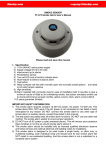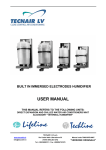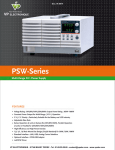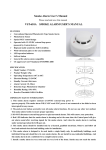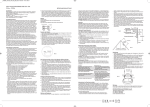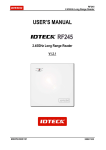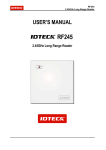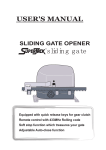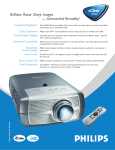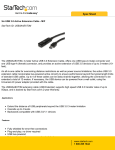Download Smoke Alarm User`s Manual
Transcript
Smoke Alarm User’s Manual PLEASE READ AND SAVE THIS MANUAL Type:SS-168P Specification: Power supplied DC9V battery or 12V/24V(ATTENTION: MUSTN‘T USE TWO POWER SUPPLY(9V BATTERY AND 12V/24V TOGETHER) Photoelectric sensor Red LED indicate alarm Unique “battery missing” lockout Low battery alarm High sensitivity Built in sounder to give a minimum sound output of 95dB at 3m Senses smoke using the light scatter principle-quick response to visible Smouldering smoke, test button simulates smoke – use to check performance at least monthly, option current ≤10uA, alarm current ≤30mA. 3 year guarantee (limited) IPMORTANT SAFETY INFORMATION 1. The test button accurately tests all smoke alarm functions. Do not use any other test method. Test smoke alarm weekly to ensure proper operation. 2. DO NOT remover or disconnect battery. This will remove your protection. Open windows or fan the air around smoke alarm silence it. 3. This smoke alarm should be installed only by a licensed, qualified electrician. Observe and follow all local and national electrical and building codes for installation. 4. This smoke alarm is designed to be used inside a single family only. In multifamily buildings, each individual living unit should have its own smoke alarms. Do not install in non-residential buildings. And this smoke alarm is not a substitute for a complete alarm system. 5. Install a smoke alarm in every room and on every level of the home. Smoke may not reach the smoke alarm for many reasons. For example, if a fire starts in a remote part of the home, on another level, in a chimney, wall, roof, or on the other side of a closed door, smoke may not teach the smoke alarm in time to alert household members. A smoke alarm will not promptly detect a fire except in the area or room in which it is installed. 6. Smoke alarm may not alert every household member every time. The alarm horn is loud in order to alert individuals to a potential danger. However, there may be limiting circumstances where a household member may not hear the alarm (i. e. outdoor or indoor noise, sound sleepers, drug or alcohol usage, the hard of hearing, etc.). If you suspect that this smoke alarm may not alert a household member, install and maintain specialty smoke alarms. Household member must hear the alarm’s warning sound and quickly respond to it to reduce the risk of damage, injury, or death that may result from fire, If a household member is hard of hearing, install special smoke alarms with lights or vibrating devices to alert occupants. 7. Smoke alarms can only sound their alarms when they detect smoke. Smoke alarms detect combustion particles in the air. They do not sense heat, flame, or gas. This smoke alarm is designed to give audible warning of a developing fire. However, many fires are fast - burning, explosive, or intentional. Others are caused by carelessness or safety hazards. Smoke may not reach the smoke alarm QUICKLY ENOUGH to ensure safe escape. 8. Smoke alarms have limitations. This smoke alarm is not foolproof and is not warranted to protect lives or property from fire. Smoke alarms are not a substitute for insurance. Homeowners and renters should insure their lives and property. In addition, it is possible for the smoke alarm to fail at any time. For this reason, you must test the smoke alarm weekly and replace every 3 years. FOR BEST PROTECTION, WE RECOMMEND THAT YOU INSTALL A SMOKE ALARM IN EVERY ROOM Typical single storey dwelling with recommended Install a smoke alarm on the ceiling of wall inside each bedroom and in the hallway outside each separate sleeping area. If a bedroom area hallway is more than 30 feet long, install a smoke alarm at each end. If there is a basement: install a smoke alarm on the basement ceiling at the bottom of the stairwell. Typical multi storey dwelling with recommended protection (see figure 2) Install a smoke alarm on the ceiling of wall inside each bedroom and in the hallway outside each separate sleeping area. If a bedroom area hallway is moiré than 30 feet long, install a smoke alarm at each end install a smoke alarm at the top of a first – to- second floor stairwell. CONNECT TO PANELS: RED + POWER BLACK - Orange NC Yellow COM Green NO DO NOT INSTALL SMOKE ALARMS 1. Near appliances or areas where normal combustion regularly occurs (kitchens, near furnaces, hot water heaters). Use specialized smoke alarm with unwanted alarm control for this areas. 2. In areas with high humidity, like bathrooms or areas near dishwashers or washing machines. Install al least 10feet away from these areas. 3. Near air returns or heating and cooling supply vents. Install at least 3 feeaway from these areas. The air could blow smoke away from the detector, interrupting its alarm. 4. In rooms where temperatures may fall below 40℉ or rise above 100℉. 5. In extremely dusty, dirty, or insect – infested areas ollse particles interfere with smoke alarm operation. TESTING THE SMOKE ALARM Test each smoke alarm to be sure it is installed correctly and operating property. 1. The push – to – test button accurately tests functions. Do not use and open flame to test this smoke alarm. You may ignite and damage the smoke alarm or your home. 2. Test smoke alarms weekly and upon returning from vacation or when no one has been in the household for several days. 3. Stand at arm’s length from the smoke alarm when testing. Test all smoke alarms weekly by doing the following. 1. Firmly depress the push – to –test button for at least 5 seconds. The smoke alarm will sound 3 short beeps followed by a 2-second pause and then repeats. The alarm may sound for up to a few of seconds after releasing the push – to – test button.. DANGER: If alarm horn sounds, and smoke alarm is not being tested, the smoke alarm is sensing smoke, THE SOUND OF THE ALARM HORN REQUIRES YOUR IMMEDDIATE ATTENTION AND ACTION. MAINTEMANCE AND CLEANING In addition to weekly testing, this smoke alarm requires yearly battery replacement and periodic cleaning to remove dust, dirt, and debris. You’d batter use good battery to make the alarm work long, some batteries can use more than 1 year. 1. Turn smoke alarm counterclockwise to detach from mounting plate. 2. 3. Gently pull down smoke alarm. Be careful not to separate wire connections. Pull out power plug from back of smoke alarm. From back of smoke alarm, lift tab to open battery pocket door. 4. Remove battery from pocket. Disconnect and discard battery from battery connector. 5. Connect a fresh 9-volt battery to connector. The battery will fit only one way. Bsure battery connector is securely attached to battery into battery terminals. 6. Place battery into battery pocket. 7. Close battery pocket door. Push down until it snaps into place. 8. Replace connector plug. Connector will snap into place. 9. Reattach smoke alarm to mounting plate by turning smoke alarm clockwise until it snaps into plate. 10. Turn on power and test smoke alarm using push-to-test button. CLEANING Clean the smoke alarm at least once a month to remove dust, dirt, or debris. Always turn off power to smoke alarm before cleaning. Using the soft brush or wand attachment to a vacuum cleaner, vacuum all sides and cover of smoke alarm. Be sure all the vents are free of debris. If necessary, turn off power and use a damp cloth to clean smoke alarm cover. IMPORTANT: Do not attempt to remove the cover of clean inside the smoke alarm. This will avoid warranty. REPAIR Caution: Do not attempt to repair this smoke alarm. Doing this will avoid your warranty. If smoke alarm is not operating property, and is still under warranty, return smoke alarm to our company. Pack it in a well-padded carton, shipping prepaid, to: If the smoke alarm is no longer under warranty, have a licensed electrician replace the smoke alarm immediately with a comparable GABEL brand smoke alarm. PRACTICE FIRE SAFETY If the smoke alarm sounds its alarm horn, and you have not pushed the test button, it is warning of a dangerous situation, Your immediate response is necessary. To prepare for such occurrences, develop family escape plans, discuss them with all household member, and practice them regularly. 1. Expose everyone to the sound of a smoke alarm and explain what the sound means. 2. Determine two exits from each room and an escape route to the outside from each exit. 3. Teach all household members to touch the door and use an alternate exit it the door is hot, Instruct them not to open the door if the door is hot, 4. Teach household members to crawl along the floor to stay below dangerous smoke, fumes and gases. 5. Determine a safe meeting place for all members outside the building. WHAT TO DO IN CASE OF FIRE 1. Do not be panic; stay calm. 2. Leave the building as quickly as possible. Touch doors to feel if they are hot before opening them. Use and alternate exit if necessary. Crawl along the floor, and do not stop to collect anything. 3. Meet at a pre-arranged meeting place outside the building. 4. Call the fire department form outside the building. 5. Do not go back inside a burning building. Wait for the fire department to arrive. These guidelines will assist you in the event of a fire, However, to reduce the chance that fires will start, practice fire safety rules and prevent hazardous situations. TROUBLESHOOTING DANGER: Always turn off power at main fuse box or circuit breaker before taking troubleshooting action. WARNING: DO NOT disconnect battery or AC power to quiet an unwanted alarm. This will remove your protection. Fan the air or open a window to remove smoke or dust. PROBLEM Smoke alarm does not sound when tested. NOTE: Push test button for at least five seconds while testing! Smoke alarm beeps about once a minute. Smoke alarm sounds unwanted alarms intermittently or when residents are cooking, taking showers, ets. The alarm sounds different than I’m used to. It starts and stops. 1. Remove smoke alarm from mounting plate and: Check that connector plug is securely attached. 2. Check that battery is properly at tuched to connector. 3.Clean smoke alarm. replace battery. See battery replacement in the maintenance and cleaning section. 1. Clean smoke alarm. See cleaning in the maintenance and cleaning section. 2. Hire an electrician to move smoke alarm to a new location. See SMOKE ALARM PLACEMENT This alarm is operating correctly. This alarm features the internationally recognized horn signal for evacuation. The horn pattern is 3 short beeps followed by a 2 second pause and then repeats. WARRANTY INFORMATION 3-year limited smoke alarm warranty Company warrants to the original consumer Purchaser each new smoke alarm to be free from defects in material and workmanship under normal use and service for a period of 3 years from the date of purchase. This warranty does not cover damage resulting from accident, misuse or abuse or lack of reasonable care of the product. In no case shall Company be liable for any incidental or consequential damages for breach of this or any other warranty express or implied, whatsoever. The bad product can be mailed to the following address with a detail explanation of problem: CE APPROVAL



